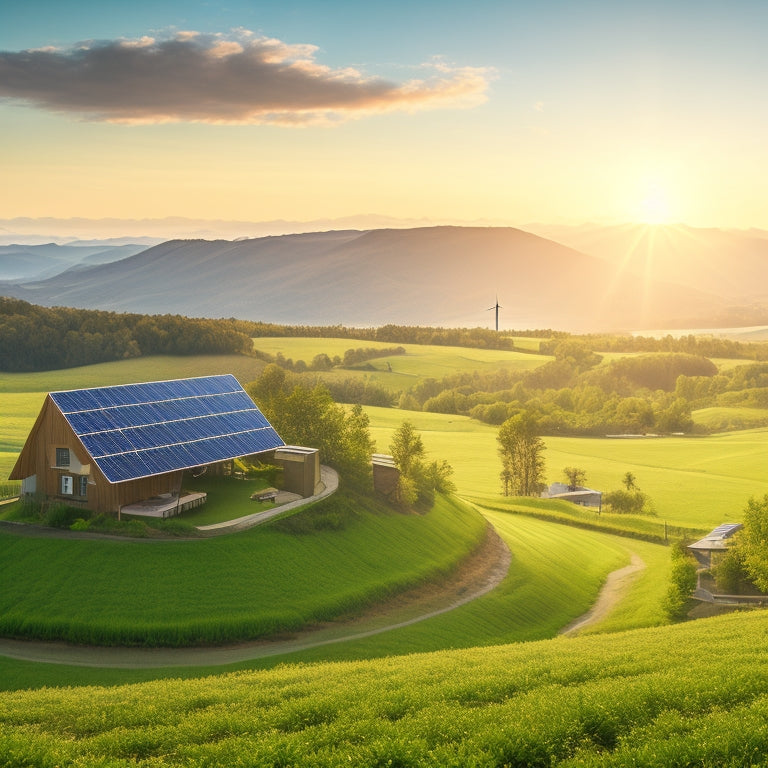
Energizing Remote Areas With Renewable Systems
Share
You're about to discover the power of renewable energy in remote areas. By harnessing natural resources like solar, wind, and hydroelectric energy, you can bring sustainable power to isolated communities, bridging the gap between rural and urban populations. Decentralized systems and energy storage solutions guarantee a stable power supply, even during periods of low energy generation. As you explore innovative off-grid solutions, you'll empower local communities to take control of their energy needs, fostering economic growth and improving quality of life - and that's just the beginning of a transformative journey to energize remote areas.
Key Takeaways
• Renewable energy systems like solar, wind, and hydroelectric power can provide reliable energy access to remote areas.
• Decentralized energy generation and storage solutions can stabilize power supply during low energy generation periods.
• Strategic location of renewable energy systems maximizes energy production while minimizing environmental impact.
• Energy storage solutions like advanced battery systems enable excess energy storage and reduce strain on the grid.
• Hybrid renewable energy systems can guarantee a stable and consistent energy supply to remote communities.
Powering Isolated Communities Sustainably
When you're tasked with powering isolated communities, you're not just providing electricity - you're bridging the gap between rural and urban populations, fostering economic growth, and improving quality of life. You're empowering communities to take control of their energy needs, promoting energy sovereignty and community trust.
By leveraging renewable energy systems, you're not only reducing reliance on fossil fuels but also mitigating the environmental impact of energy production.
In remote areas, energy access is a critical component of sustainable development. By providing reliable and clean energy, you're enabling communities to access essential services like healthcare, education, and communication. Energy sovereignty allows communities to make informed decisions about their energy needs, reducing reliance on external parties. This, in turn, fosters community trust, as locals take ownership of their energy future.
Off-Grid Renewable Energy Solutions
As you explore ways to power isolated communities, you're likely to find that off-grid renewable energy solutions, such as solar, wind, and hydroelectric systems, offer a reliable and sustainable means of electrification.
These decentralized systems enable communities to generate their own energy, reducing reliance on diesel generators and minimizing carbon emissions.
To guarantee grid resilience, energy storage systems like batteries are integrated into the design, providing a stable power supply during periods of low energy generation.
This hybrid approach enables communities to benefit from the advantages of each technology, maximizing energy production and reducing energy waste.
By leveraging advanced energy storage solutions, you can optimize energy distribution, reduce losses, and improve overall grid resilience.
As a result, off-grid renewable energy solutions can provide a reliable, sustainable, and efficient means of powering remote communities, enhancing energy access and improving the quality of life for residents.
Harnessing Natural Resources Efficiently
By strategically locating renewable energy systems near natural resources, you can capitalize on the unique characteristics of each environment to maximize energy production and minimize environmental impact. This approach enables you to harness the full potential of natural resources, such as wind, solar, and hydro power, to generate clean energy.
To guarantee a reliable supply of energy, incorporating energy storage solutions is essential. This can be achieved through advanced battery systems that store excess energy generated during peak production periods, providing a buffer against energy fluctuations.
Reliable Energy Access Guaranteed
You can rely on renewable systems to provide reliable energy access, thanks to the strategic integration of energy storage solutions that mitigate the variability of natural resources.
By incorporating advanced energy storage systems, you can guarantee a stable and consistent energy supply, even in areas with limited grid connectivity. This is particularly important for remote communities that rely heavily on renewable energy sources.
Energy storage solutions, such as batteries and flywheels, play an essential role in enhancing grid resiliency. By storing excess energy generated during periods of high renewable output, you can secure a steady supply of power during periods of low energy production.
This not only ensures reliable energy access but also reduces the strain on the grid, minimizing the risk of power outages and grid instability.
With reliable energy access guaranteed, you can power critical infrastructure, communication networks, and essential services, fostering economic growth and social development in remote areas.
Empowering Rural Development Through Tech
Rural communities can leapfrog traditional development stages by harnessing the power of technology to overcome energy and infrastructure deficits. You can bridge the Digital Divide by leveraging innovative solutions that bring Rural Connectivity to underserved areas. This enables rural communities to access essential services, information, and opportunities that were previously out of reach.
Some key strategies to empower rural development through tech include:
-
Digital Literacy Programs: Educate rural inhabitants on basic computer skills, online safety, and digital tools to enhance their socio-economic prospects.
-
Mobile Health Services: Leverage telemedicine and mobile health platforms to provide quality healthcare services, reducing the need for rural residents to travel long distances for medical care.
-
E-Government Platforms: Implement digital platforms for rural citizens to access government services, submit applications, and track progress, reducing bureaucratic hurdles.
- Rural Wi-Fi Networks: Establish reliable, high-speed internet connectivity to facilitate online learning, entrepreneurship, and digital commerce in rural areas.
Frequently Asked Questions
Can Renewable Energy Systems Be Integrated With Existing Grid Infrastructure?
"As you ponder the possibilities, you'll find that seamlessly synchronizing renewable energy systems with existing grid infrastructure is feasible through strategic Grid Expansion and Infrastructure Upgrade, paving the way for a sustainable future."
How Do You Ensure Energy Storage for Remote Areas With Intermittent Power?
You'll secure energy storage for remote areas with intermittent power by implementing advanced Battery Management systems, leveraging Energy Forecasting to optimize charging and discharging, and utilizing smart grids to stabilize the flow of renewable energy.
Are There Any Government Incentives for Rural Renewable Energy Projects?
As you navigate the wilderness of rural renewable energy projects, you'll find a treasure trove of government incentives waiting to be unearthed, including lucrative Tax Credits and Grant Funding, helping you illuminate the path to a brighter, sustainable future.
Can Local Communities Be Involved in the Planning and Maintenance of Systems?
You empower local communities by involving them in planning and maintenance, fostering community engagement and local empowerment, ensuring they're invested in the system's success and take ownership of their renewable energy future.
Are Renewable Energy Systems Resistant to Extreme Weather Conditions?
You'll find that renewable energy systems are designed with weather resilience and climate adaptability in mind, ensuring they can withstand extreme weather conditions, such as hurricanes, wildfires, and floods, without compromising performance.
Related Posts
-

Top Portable Refrigerators for Camping Adventures
When you're camping, having a reliable portable refrigerator can make all the difference for keeping your food fresh ...
-

Home Solar Installation Cost
You're considering installing solar panels on your home, and the upfront cost is likely the biggest hurdle standing i...
-

Smart Grid Technology Implementation Challenges
You'll encounter several challenges when implementing smart grid technology, particularly in cost management, scalabi...


